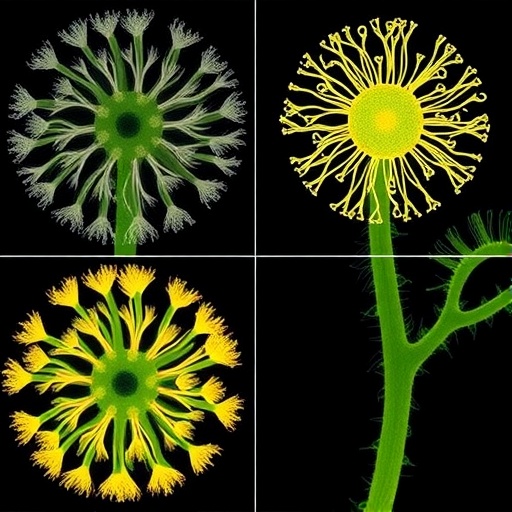In a groundbreaking study shedding light on the complex world of plant genetics, researchers conducted an in-depth comparative karyological analysis of two notable species within the Mimosa genus: the diploid Mimosa diplotricha and the hexaploid Mimosa pudica. This research, spearheaded by Dash, Anjum, and Sultana, aims to elucidate the chromosomal characteristics and structural variations that contribute to the understanding of evolutionary biology and taxonomy in angiosperms.
The study’s crucial objective was to unravel the genetic intricacies that differentiate Mimosa diplotricha from Mimosa pudica. In an age where biodiversity is increasingly threatened, understanding such genetic differences is essential for conservation efforts and for informing potential applications in agriculture and medicine. Karyological analysis, which examines the number and visual appearance of chromosomes, offers a glimpse into the evolutionary adaptations that have occurred within these species, providing scientists with valuable data for future research.
Chromosomal morphology was meticulously analyzed using advanced techniques, including fluorescence in situ hybridization (FISH), enabling the identification of specific chromosomal markers. This sophisticated method allowed the research team to visualize and characterize the chromosomal patterns of both species at a granular level. By employing FISH, the researchers could discern the structural variations that exist between the diploid and hexaploid species, shedding light on their respective evolutionary pathways.
The findings revealed that Mimosa diplotricha possesses a distinct chromosomal layout compared to its hexaploid counterpart, Mimosa pudica. The research highlights that while M. pudica boasts an increased chromosome count, it exhibits specific structural adaptations that may confer advantages in certain ecological niches. This aspect is critical when considering the evolutionary pressures that have led to the diversification of the species within this genus.
Furthermore, the implications of polyploidy, a condition where cells have more than two paired sets of chromosomes, cannot be understated. The hexaploid nature of Mimosa pudica suggests that its evolution involved hybridization events that allowed it to thrive in a variety of environments. This study posits that polyploidy might have played a significant role in its success and adaptation, providing insights into how this phenomenon contributes to plant biodiversity and resilience.
In examining the implications for taxonomy, the authors emphasized the need for a refined classification system that takes chromosomal differences into account. The traditional morphological characteristics often used for species differentiation may not fully encapsulate the genetic variability present within the Mimosa genus. By promoting a karyological perspective, the authors advocate for a more nuanced understanding of plant taxonomy that incorporates genetic data and chromosomal analysis.
The research also holds great promise for practical applications, particularly in the fields of agriculture and horticulture. Understanding the chromosomal distinctions between these two species could lead to innovative strategies for crop improvement. For instance, the traits expressed in Mimosa pudica may be harnessed to develop pest-resistant varieties or improve stress tolerance in economically important crops.
The study’s findings are already generating buzz within the scientific community, as they invite further investigation into the genetic underpinnings of plant species and their evolutionary relationships. This research not only enhances our understanding of the Mimosa genus but also serves as a model for studying other plant groups that exhibit similar chromosomal complexity.
In light of climate change and habitat destruction, the investigation into plant genetics and their adaptive mechanisms becomes more critical than ever. This study paves the way for conservation biology by providing insights that can inform strategies to preserve biodiversity. As habitats continue to change, understanding the genetic adaptability of plant species will be crucial in predicting their future survival and potential for regeneration.
Moreover, the research combines traditional botanical studies with modern genetic techniques, illustrating the importance of interdisciplinary approaches in contemporary scientific research. By collaborating across fields, such as botany, genetics, and environmental science, researchers can gain comprehensive insights into the dynamics of plant evolution and ecology.
Overall, the comparative karyological analysis conducted by Dash and colleagues represents a significant advancement in our understanding of plant genetics and taxonomy. As the findings continue to be disseminated, they will undoubtedly inspire future research endeavors aimed at unraveling the complexities of plant diversity in a changing world.
As we move forward, it is essential for the scientific community to recognize the importance of integrating various methodologies in plant research. The revelations from this study not only challenge existing paradigms but also reinforce the idea that the genetic basis of biodiversity must be a key focus in ecological and evolutionary studies.
In conclusion, this study on the diploid Mimosa diplotricha and hexaploid Mimosa pudica provides crucial insights into the evolutionary processes shaping plant diversity. It opens avenues for further research that could expand our understanding of crop genetics and ecological adaptations, making it a vital contribution to the fields of botany and environmental science.
Subject of Research: Comparative karyological analysis of diploid Mimosa diplotricha and hexaploid M. pudica
Article Title: Comparative karyological analysis of diploid Mimosa diplotricha and hexaploid M. pudica with taxonomic insights.
Article References:
Dash, C.K., Anjum, N., Sultana, S. et al. Comparative karyological analysis of diploid Mimosa diplotricha and hexaploid M. pudica with taxonomic insights.
Discov. Plants 2, 341 (2025). https://doi.org/10.1007/s44372-025-00430-x
Image Credits: AI Generated
DOI: https://doi.org/10.1007/s44372-025-00430-x
Keywords: Comparative karyology, Chromosomal analysis, Mimosa genus, Polyploidy, Taxonomy, Plant genetics, Evolutionary biology, Biodiversity, Conservation, Agricultural applications.




